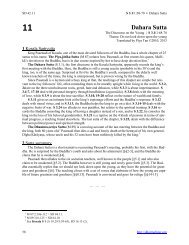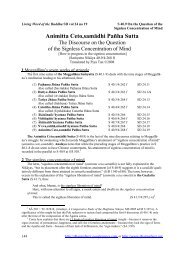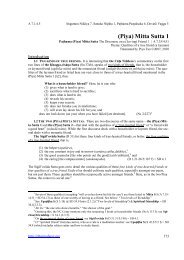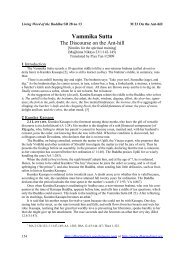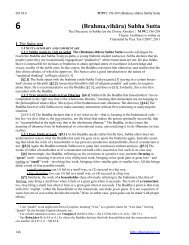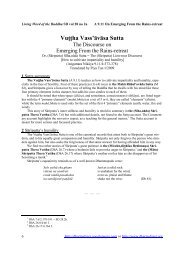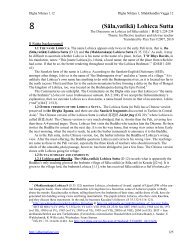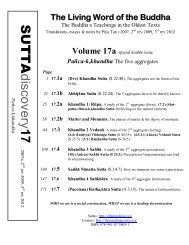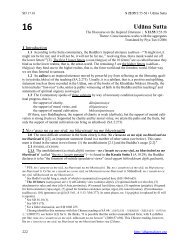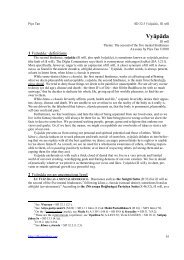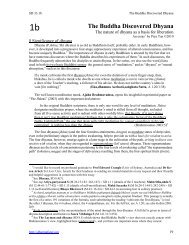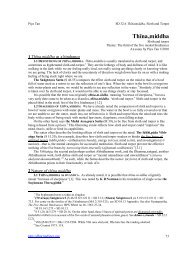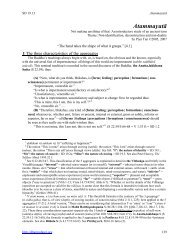Puttamamsa Sutta - The Dharmafarers
Puttamamsa Sutta - The Dharmafarers
Puttamamsa Sutta - The Dharmafarers
Create successful ePaper yourself
Turn your PDF publications into a flip-book with our unique Google optimized e-Paper software.
S 2.1.7.3 Saṁyutta Nikāya 2, Nidāna Vagga1, Nidāna Saṃyutta 7, Mahā Vagga 3<br />
6<br />
Putta,masa <strong>Sutta</strong><br />
<strong>The</strong> Discourse on the Son‘s Flesh | S 12.63/2:97-100<br />
<strong>The</strong>me: <strong>The</strong> true nature of food<br />
Translated & annotated by Piya Tan ©2006<br />
Der Mensch ist, was ir isst<br />
(A man is what he eats. German proverb)<br />
1 Introduction<br />
It is imperative to understand here that this <strong>Sutta</strong> (or Buddhism as a whole) does not advocate or endorse<br />
cannibalism, which is clearly prohibited by the Vinaya. 1 <strong>The</strong> Putta,maṁsa <strong>Sutta</strong> tries to say in the<br />
strongest terms, how we are attached to our bodies, and yet not knowing its true nature. We need to understand<br />
the true nature of our mind-body.<br />
1.1 ORIGIN STORY. <strong>The</strong> Putta,maṁsa <strong>Sutta</strong>—the discourse on the son‘s flesh—as the title suggests,<br />
is a set of strong statements on nibbidā, 2 regarding how life and suffering are fuelled by the four kinds of<br />
food, namely, material food, sense-stimuli, mental volition and consciousness. Bodhi, in the Introduction<br />
to his translation of the Nidāna,vagga of the Saṁyutta, says that the Putta,maṁsa <strong>Sutta</strong><br />
[is] entirely devoted to the four nutriments with no explicit mention made of dependent origination,<br />
introduced four thought-provoking similes to expose the dangers in the four nutriments and<br />
to inspire a sense of revulsion towards the whole process of nutrition. Because at least three of the<br />
four nutriments are internal to the sentient organism itself, the teaching of the four nutriments<br />
implies, at a very deep level, that sentient existence not only requires nutriment from outside but<br />
is itself a self-sustaining process of nutrition. (S:B 524)<br />
<strong>The</strong> <strong>Sutta</strong>‘s Commentary explains that the Buddha gives this teaching because the monastic order has<br />
been receiving an abundance of gifts and honour (lābha,sakkāra), and that some of the monks are not<br />
using their requisites with proper reflection. Indeed, the situation is so urgent that the Buddha is represented<br />
as giving this teaching as ―the fifth rule of defeat‖ (pañcama pārājika), that is, a rule which when<br />
broken entails automatic defeat or fall from monkhood. To prevent this, he places before the monks (by<br />
way of this teaching) ―a mirror of the Dharma‖ (dhamm’ādāsa) for their self-restraint. Constantly<br />
reflecting on this teaching, they would use the four requisites—almsfood, robes, shelter and medical<br />
requisites—with restraint (saṁvara) and proper limits [strictly defined relationships] (mariyāda). (SA<br />
2:101 f).<br />
1.2 SUMMARY. <strong>The</strong> Putta,maṁsa <strong>Sutta</strong> is quite straight-forward: the Buddha teaches unprompted by<br />
first stating the syllabus [§§2-3] and then he elaborates on it in a simple dialogue. However, it is interesting<br />
that each of the four teachings of ―food‖ (āhāra) is expanded by a powerful simile that clearly evokes<br />
nibbidā by way of the Dharma mastered, thus:<br />
Food Simile Dharma mastered<br />
(1) material food [§4] an only son‘s flesh [§§5-11a] sensual lust [§11b]<br />
(2) contact as food [§12] a skinless cow [§13] feeling [§14]<br />
(3) mental volition as food [§15] a fiery coal-pit [§§16-17] craving [§18]<br />
(4) consciousness as food [§19] a punished thief [§§20-24] name-and-form [§25]<br />
1 According to the Vinaya, the following types of meat are not allowable for monastics: human flesh, elephant<br />
meat, horse meat, dog meat, snake meat, lion meat and meat of all other wild animals (Mv 6.23-24 = V 1:217-220).<br />
Only available meat (pavatta,maṁsa), ie, the killing of which the monastic has not seen, heard or suspected is done<br />
specially for him or her, is allowable (V 1:217; 3:172).<br />
2 See SD 20.1.<br />
http://dharmafarer.org 51
SD 20.6 S 12.63/2:97-100 • Putta,maṁsa <strong>Sutta</strong><br />
<strong>The</strong> <strong>Sutta</strong> ends abruptly, as it were, but this suggests that the teaching is addressed to us directly, and that<br />
the Buddha expects us to complete the <strong>Sutta</strong> ourselves with our own attainment of awakening.<br />
1.3 RELATED SUTTAS AND TEXTS. <strong>The</strong> following three suttas have important sections dealing with<br />
―food,‖ namely, the Sammā Dihi <strong>Sutta</strong> (M 9), 3 the Mahā Tahā,sakhaya <strong>Sutta</strong> (M 38), 4 and the<br />
(hara) Kya <strong>Sutta</strong> (S 46.2). 5 <strong>The</strong> term ―food‖ is also briefly mentioned in the (Upādāna) Parivaa<br />
<strong>Sutta</strong> (S 22.56):<br />
52<br />
And what, monks, is form?<br />
<strong>The</strong> four great elements 6 and forms derived 7 from the four great elements—this is called ―form.‖<br />
With the arising of food, there is the arising of form.<br />
With the cessation of food, there is the cessation of form. (S 22.56/3:59)<br />
Āhāra is further discussed in the Moḷiya Phagguna <strong>Sutta</strong> (S 12.12) from the perspective of non-self, 8<br />
and the Atthi,rāga <strong>Sutta</strong> (S 12.64), where it is said that lust for ―food‖ brings on suffering. 9<br />
<strong>The</strong> Āhāra <strong>Sutta</strong> (S 46.51), using the term āhāra in a broader sense, without reference to the four<br />
kinds of food, shows how the mental hindrances are fed or fuelled, how the awakening-factors are starved,<br />
so that we do not progress spiritually; and how the hindrances are starved, and the awakening-factors<br />
nourished, so that we progress spiritually towards awakening. 10 <strong>The</strong> Abhisaa <strong>Sutta</strong>s (S 55.31-33), too,<br />
uses the term hra in a broader sense. 11<br />
<strong>The</strong> Visuddhi,magga, too, discusses āhāra. 12 <strong>The</strong> Putta,maṁsa <strong>Sutta</strong> and its long commentary are<br />
fully translated with related texts and notes in Nyanaponika <strong>The</strong>ra‘s <strong>The</strong> Four Nutriments of Life (1981). 13<br />
2 True nature of food<br />
2.1 PURPOSE OF THE TEACHING. In the Boy‟s Questions (kumāra,pañha) (Khp 4), the very first<br />
question and answer are:<br />
What is ―one‖ (eka nāma kiṁ): ―All beings are sustained by food‖ (sabbe sattā āhāra-ṭ,ṭhitikā). 14<br />
(Khp 4/2 & KhpA 75-78)<br />
<strong>The</strong> same question and answer are found in another similar set of ten questions in the Mahā Pañha <strong>Sutta</strong><br />
1 (A 10.28), and where the fourth question and answer are:<br />
Bhikshus, when a monk becomes fully revulsed towards four things, when his lust for them<br />
fully fades away, when he is fully liberated from them, when he sees the complete ending of<br />
them, then he is one who, having fully realized the goal, makes an end of suffering here and now.<br />
In what four things?<br />
In the four kinds of food. (A 10.27.6/5:50 f) 15<br />
3<br />
M 9.9/1:47 f.<br />
4<br />
M 38.15-16/1:261.<br />
5<br />
S 46.2/5:64-67.<br />
6<br />
―<strong>The</strong> 4 great elements,‖ (cattro mah,bhūt). See (Upādāna) Parivaa <strong>Sutta</strong> (S 22.56) in SD 3.7.7n.<br />
7<br />
On the ―derived elements,‖ see (Upādāna) Parivaa <strong>Sutta</strong> (S 22.56) in SD 3.7.7n.<br />
8<br />
S 12.12/12-14 = SD 20.5.<br />
9<br />
S 12.64/101-104.<br />
10<br />
S 46.51/5:102-107 = SD 7.15. See esp its Intro.<br />
11<br />
S 55.31-33/5:391-392. See also S:B 731 n19 (<strong>The</strong>se four kinds of nutriments have craving as their source).<br />
12<br />
Vism 11:1-3/341.<br />
13<br />
See biblio. For Comy tr, see pp 17-27.<br />
14<br />
Khp 4/2 = D 3:211; cf D 3:273 = Pm 1:5 (katamo eko dhammo abhiññeyāyo); S 5:65+65 (pañca nīvaraṇā<br />
āhāraṭṭhitikā); S 5:65+67 (satta bojjhaṅgā āhāraṭṭhitikā); Pm 1:122+174 = 2:34 (in answer to eko loko), UA 207,<br />
SnA 2:442, J 1:131, Nc 40. See also KhpA 77 f; PmA 1:65, 67; also A 10.27/5:48-54.<br />
http://dharmafarer.org
S 2.1.7.3 Saṁyutta Nikāya 2, Nidāna Vagga1, Nidāna Saṃyutta 7, Mahā Vagga 3<br />
Two important points are evident from the Mahā Pañha <strong>Sutta</strong> passage here. Firstly, the four kinds of<br />
food form a single set, the ―one dharma‖ (eka,dhamma), that is, they are to be understood as a set. Secondly,<br />
the purpose of reflecting on the four kinds of food is to arouse nibbidā, revulsion towards the<br />
virtual reality we create as a very private limited world of our own. Nibbidā is like the proverbial chicken‘s<br />
beak or claw with which it breaks through the shell of ignorance so that it emerges into the open<br />
fresh air of true reality. A medieval Jewish sage was once moved to say, ―I am fed up with being hungry<br />
again and again, and I hunger after final satiety.‖ 16<br />
2.2 THE FOUR FOODS DEFINED. <strong>The</strong> suttas, such as the Putta,masa <strong>Sutta</strong> (S 12.63), often mention<br />
four kinds of food or nutriment (hra), namely: solid food, contact (sense-stimuli), volition, consciousness.<br />
17 <strong>The</strong> Commentaries give very detailed analyses of āhāra. <strong>The</strong>y are called āhāra because<br />
―they nourish‖ (aharanti) their own effects, and that they have craving as their source. Although there are<br />
other conditions for beings, these four alone are called ―food‖ because they serve as ―special conditions<br />
for the personal life-continuity‖ (ajjhatika,santatiy visesa,paccayatt). 18 That is to say, with this special<br />
condition, that particular state does not arise.<br />
Material food (kabalikra hra) is basically the kind of solid food that we take to sustain or build<br />
our physical body. This is the support for the physical body that is the stage, as it were, for the other three<br />
kinds of non-material food.<br />
In the mental body, contact is the special condition for feeling, and contact as food produces the 3<br />
kinds of feelings, that is, the pleasurable, the painful and the neutral. 19<br />
Mental volition is the special condition for consciousness, and mental volition as food produces the<br />
3 kinds of existence, that is, the sense-world, the form world, and the formless world.<br />
Consciousness is the special condition for name-and-form, and consciousness as food produces<br />
name-and-form on the occasion of rebirth.<br />
In summary, the products of food (what it nourishes) as the special condition are as follows:<br />
(1) material food (kabaḷīṅkāra āhāra) put into the mouth produces the groups of ―form with nutritive<br />
essence as the eighth‖ (oj’ahamaka,rūpa); 20<br />
(2) contact as food (phass’hra) produces the three kinds of feeling (pleasurable, painful, neutral);<br />
(3) mental volition as food (mano,sañcetan’āhra) produces the three kinds of existence [senseworld,<br />
form-world, formless world]; and<br />
(4) consciousness as food (viññ’hara) produces name-and-form (nma,rūpa) at rebirth.<br />
(MA 1:207-215; SA 2:22-27, 104-113; KhpA 76-78)<br />
Let us now examine these four kinds of food in greater detail.<br />
15 Catūsu bhikkhave dhammesu bhikkhu sammā nibbindamāno sammā virajjamāno sammā vimuccamāno sammā<br />
pariyanta,dassāvī sammatthâbhisamecca diṭṭh’eva dhamme dukkhass’antakaro hoti. Katamesu catūsu? Catūsu<br />
āhāresu.<br />
16 Abraham ben Chisdai, in Ben-hamelekh we-hanasir (<strong>The</strong> Prince and the Ascetic). This is an old Hebrew version<br />
of the ―Barlaam and Joasaph‖ story which unwittingly carried the main features of the Buddha's life story through a<br />
major part of the medieval world. <strong>The</strong> Hebrew version has several distinct traces not only of the Buddha‘s life story,<br />
but also of Buddhist ideas, like the one quoted above. Only a comparison of the numerous versions of the ―Barlaam<br />
and Joasaph‖ story could decide on whether these ideas were part of the tradition and common to other versions, or<br />
whether they originated in the Hebrew author's mind. This is from Nyanaponika 1981.<br />
17 D 3:228; M 1:48, 261; S 2:13, 48, 98-105; Vbh 401.<br />
18 MA 1:209; SA 2:26; DhsA 153. See also Vism 11.1-3/341. In hra S (S 46.61/5:102-107) & Abhisaa Ss<br />
(S 55.31-33/5:391-392) hra is used in a broader sense of ―special condition‖ without reference to the four kinds of<br />
food. See also S:B 731 n19 (<strong>The</strong>se 4 kinds of nutriment have craving as their source).<br />
19 On feeling, see Vedanā = SD 17.3.<br />
20 Ie, it is the basic corporeal octad (suddh’aṭṭhaka), consisting of the 4 great elements, colour, smell, taste, and<br />
nutritive essence. On oja,ahamaka,rūpni, see SD 26.2 esp (3).<br />
http://dharmafarer.org 53
SD 20.6 S 12.63/2:97-100 • Putta,maṁsa <strong>Sutta</strong><br />
2.2.1 Material food (kabalikra hra) is the special condition (visesa paccaya) for the physical<br />
body of those beings that subsist on material food, of the gross (solid) kind in the case of the physical<br />
sense-world, or the subtle in the case of the sense-based celestial worlds. <strong>The</strong> Commentary says that<br />
kabaliṅkār’āhāra is ―a term for the nutritive essence (ojā) of which boiled rice, etc, is the base (vatthu)‖<br />
(SA 2:22-24). Material food, as soon as it is placed in the mouth (in the case of humans), brings forth the<br />
groups of form with nutritive essence as the eighth (oja ahamaka,rūpa, an Abhidhamma term for the<br />
simplest cluster of material states). 21<br />
<strong>The</strong> word kabaḷiṅ,kāra (Ee Se) or kavaḷiṅ,kāra (Ce) or kabaḷī,kāra (Be), is resolved as kabala (―morsel,<br />
mouthful‖) + kāra (―doing, making‖), and means ―made into morsels‖ (but is used only in combination<br />
with āhāra as a phrase or a compound). As such, the compound, kabaḷiṅkār’āhāra 22 (and its variant<br />
forms) means ―material food.‖ <strong>The</strong> word ―material‖ is broad enough here to encompass the senses ―physical‖<br />
food, as applied to the human and physical world, while the term ―non-physical‖ or ―fine (or subtle)‖<br />
food as applied to the sense-bound celestial worlds.<br />
<strong>The</strong> Brahma,jāla <strong>Sutta</strong> (D 1) speaks of ―the divine, having physical form, of the sense-sphere, partaking<br />
of solid food,‖ 23 which clearly suggests that the term kabaḷiṅkāra āhāra applies to the whole of the<br />
sense-world. Moreover, the Putta,maṁsa <strong>Sutta</strong> clearly states two kinds of ―material food,‖ that is, the<br />
gross (oḷārika) and the fine [subtle] (sukhuma) (kabalīkāro āhāro oḷāriko vā sukhumo vā), where ―gross‖<br />
refers to the solid food, such as those of human beings, and ―fine‖ or ―subtle‖ to that of the sense-world<br />
divine beings. <strong>The</strong> beings of higher worlds do not partake of any such food.<br />
2.2.2 Contact as food. In the mental body, contact is the special condition for feeling, and contact<br />
as food brings forth the three kinds of feelings, pleasurable, painful and neutral. 24 Contact or sense-impression<br />
occurs because we have a physical body nourished by food, ―made consisting of the four great<br />
elements, procreated by mother and father, nourished on boiled rice and porridge.‖ 25<br />
In Buddhist psychological terms, this body comprises of the six sense-faculties (eye, ear, nose, tongue,<br />
body and mind), which in conjunction with their respective sense-objects and sense-consciousnesses,<br />
26 result in sense-contact (phassa), from which arises feeling (vedanā), which refers to the hedonic tone<br />
or affective value of the resultant experience. For example, the meeting of eye, form, and eye-consciousness<br />
is called eye-contact. Contact, according to dependent arising (paicca,samuppāda), is the principal<br />
condition for feeling. Feeling and perception are inseparable. 27 Hence, contact produces feelings.<br />
2.2.3 Mental volition as food. Mental volition is the special condition for consciousness, and mental<br />
volition as food produces the three kinds of existence, that is, the sense-world, the form world, and<br />
the formless world. <strong>The</strong> Commentary says that mano,sañcetanā is identical with cetanā (―volition‖), and<br />
here refers to karmic volition (SA 2:24). As noted by Gethin, cetanā is closely related to saṅkhāra:<br />
54<br />
<strong>The</strong> nikāyas define sakhāras primarily in terms of will or volition (cetanā); they also<br />
describe them as putting together (abhisakharonti) each of the khandhas in turn into something<br />
that is put-together (sakhata). 28 In this way sakhāras are presented as conditioning factors conceived<br />
of as active volitional forces. Cetanā is, of course, understood as kamma on the mental<br />
level, 29 … (Gethin 1985:37)<br />
21<br />
On oja,ahamaka,rūpni, see SD 26.2 esp (3). See prec n.<br />
22<br />
BHS kavalī,kārâhāra.<br />
23<br />
Dibbo rpī kāmâvacāro kabaliṅkār’āhāra,bhakkho, D 1.86/1:34 = SD 25.2.<br />
24<br />
On feeling, see Vedanā = SD 17.3.<br />
25<br />
Cātum,mahā,bhūtikassa kāyassa…mātā,pettika,sambhavassa odana,kummāsûpacayassa (Vammika S, M<br />
23.4/1:144; Udaka S, S 4:83 f; Kiṁsukopama S, S 4:194; Kāma,bhū S, S 4:292; Gaṇḍa S, A 4:386).<br />
26<br />
<strong>The</strong> meeting of these three is contact (tiṇṇaṁ saṅgati phasso) (Madhu,piṇḍika S, M 18.16/1:111) = SD 6.14.<br />
27<br />
Mahā Vedalla S (M 43.9/1:293) = SD 35.1.<br />
28<br />
Eg Khandha Sayutta defs, S 3:59 f, 86 f. (Gethin‘s fn)<br />
29 A 3:425. (Gethin‘s fn)<br />
http://dharmafarer.org
S 2.1.7.3 Saṁyutta Nikāya 2, Nidāna Vagga1, Nidāna Saṃyutta 7, Mahā Vagga 3<br />
<strong>The</strong> formations aggregate (saṅkhāra-k,khandha) is a comprehensive group comprising a number of<br />
volitional factors. <strong>The</strong> most important is volition (cetanā), the mental factor that causes us to act by way<br />
of body and speech. Mental formations do not include feeling (which forms its own aggregate) but includes<br />
all the different desires and emotions, including the wholesome and unwholesome roots. <strong>The</strong>y are the<br />
psychological roots of unwholesome actions (greed, hatred and delusion), and of wholesome actions (charity,<br />
lovingkindness and wisdom). As the second factor of dependent arising, sakhārā are the karmically<br />
active volitions responsible, in conjunction with ignorance and craving, for producing rebirth and clinging<br />
on to the wheel of existence. 30<br />
2.2.4 Consciousness as food. Consciousness is the special condition for name-and-form, and consciousness<br />
as food produces name-and-form on the occasion of rebirth. <strong>The</strong> relationship between consciousness<br />
(viāa) and name-and-form (nāma,rpa), and this relationship is the heart of dependent arising.<br />
31<br />
When name-and-form is correlated with the five aggregates (paca-k,khandha), 32 form is identified<br />
with the aggregates of physical form (rpa), and name with the three aggregates of feeling (vedanā), perception<br />
(saā) and mental formations (sakhāra) (Vism 17.187/644 f). 33 Consciousness (viāa), although<br />
inseparably linked with the three mental aggregates, is not included here as it is the condition for<br />
name-and-form. Hence, the Vibhaga <strong>Sutta</strong> (S 12.2) gives this definition of name-and-form:<br />
And what, bhikshus, is name-and-form? Feeling, perception, volition, contact, attention.<br />
This is called name. And the four great elements and the material form derived from the four<br />
great elements. This is called form. Thus this is name and this is form—this is called name-andform.<br />
(S 12.2.12/2:3) = SD 5.15<br />
<strong>The</strong> Mahā,nidāna <strong>Sutta</strong> (D 15) explains the connection between consciousness and name-and-form,<br />
and how they lead to existence, in this manner:<br />
It is said: „With consciousness as condition, there is name-and-form.‟ nanda, how<br />
consciousness conditions name-and-form should be known in this manner:<br />
If there were no consciousness to descend into a mother‘s womb, would name-and-form take<br />
shape in the womb?‖ 34<br />
―Certainly not, bhante.‖<br />
If, after descending into the mother‘s womb, the consciousness were to depart, would nameand-form<br />
be generated in this state of being here?‖<br />
―Certainly not, bhante.‖<br />
30 For a detailed study, see Saṅkhāra = SD 17.6.<br />
31 This is in fact the theme of Mahā,nidāna S (D 15/2:55-71) = SD 5.17.<br />
32 <strong>The</strong> 5 aggregates: for a general survey, see (Updna) Pariva S (S 22.56) = SD 3.7; for study of the indi-<br />
vidual aggregates, see SD 17.<br />
33 On some technical difficulties regarding this term, see Bodhi 1984:18 n1, Harvey 1993:3-5 (digital ed) &<br />
Hamilton 1996a ch VI, esp 124-127.<br />
34 Cf Titth‟āyatana S (A 3.61) where the Buddha declares: ―Based on the six elements, there is descent into the<br />
womb; | (On account of) such a descent, there is name-and-form; | With name-and-form as condition, there is contact;<br />
| With contact as condition, there is feeling. | Now, it is for one who feels that I make known [the 4 noble<br />
truths]‖ (A 3.61.9/1:176). This clearly shows that feeling arises with the descent of the gandharva (rebirth consciousness)<br />
into the womb. However, this is not a common interpretation of viāa-nāma,rpa dyad, where ―viāa in<br />
this context became the consciousness that descends into the mother‘s womb at conception, while nāma-rpa became<br />
the body complex that takes shape and, after developing sense-organs (saāyatana), experiences contact (phassa)<br />
and so on.‖ (Bucknell 1999:339). More commonly, viāa is ―the consummation of the six types of consciousness<br />
associated with the sense organs, which makes the version read like an account of the psychological process of<br />
sensory perception.‖ (Bucknell 1999: 327): see Madhu,piika S (M 18.16-18/1:111-113). See discussion on<br />
nāma,rpa in Dependent arising = SD 5.11 Intro.<br />
http://dharmafarer.org 55
SD 20.6 S 12.63/2:97-100 • Putta,maṁsa <strong>Sutta</strong><br />
56<br />
―If the consciousness of a young boy or a young girl were to be cut off, would name-andform<br />
grow, develop and mature?‖<br />
―Certainly not, bhante.‖<br />
―<strong>The</strong>refore, nanda, this is the cause, the source, the origin, the condition for name-andform,<br />
that is to say, consciousness. (D 15.21/2:62 f) = SD 5.17<br />
2.3 THE FOUR SIMILES. <strong>The</strong> Putta,masa <strong>Sutta</strong> (S 12.63) gives a full definition of the four kinds<br />
of food, along with four graphic similes:<br />
(1) material food = an only son‘s flesh;<br />
(2) contact as food = a skinless cow;<br />
(3) mental volition as food = charcoal pit;<br />
(4) consciousness as food = a man given 300 strokes of the spear. 35<br />
Here we will examine the four similes a little more closely.<br />
2.3.1 <strong>The</strong> simile of the only son‟s flesh [§§5-11a]. <strong>The</strong> simile of the only son‘s flesh is perhaps the<br />
grimmest simile in Pali literature, and is especially so when contrasted with another simile of the only son<br />
(eka,putta) in the (Karaṇīya) Metta <strong>Sutta</strong> (Khp 9 = Sn 1.8), lovingkindness should be cultivated in the<br />
same way ―as a mother would guard her own child, | her one and only child, with her own life.‖ 36 That<br />
being the case, the simile of the only son‘s flesh is even more poignant is arousing revulsion (nibbidā)<br />
towards material food.<br />
On a practical level, the monastic is admonished to use his almsfood in the way that the couple eat<br />
their only son‘s flesh: without greed or desire, without pickiness, without gorging themselves, without<br />
selfishness, without any delusion about what they are eating, without longing to eat such food again,<br />
without hoarding, without pride, without disdain, and without quarrelling. (SA 2:108)<br />
On a spiritual level, that of mindfulness training, the simile of the only son‘s flesh is perfectly understandable:<br />
we need a powerful call or shake to be woken from our soporific dream-like life driven on by<br />
greed, hate and delusion. A lighter example is found in the Cūḷa Taṇhā,saṅkhaya <strong>Sutta</strong> (M 378), where<br />
Moggallāna psychically shakes up the celestial Vejayanta mansion in the Heaven of the 33 to waken the<br />
gods there to a lesson on spiritual urgency the Buddha has earlier taught them. 37<br />
2.3.2 <strong>The</strong> simile of the skinless cow [§13]. Just as a cow, seeing the danger of being bitten [devoured]<br />
by creatures living in the places it might seek refuge in, would not wish to be honoured or venerated,<br />
or to have her back cleaned, or to be massaged, or given warm baths, etc; even so, a monk, seeing the<br />
danger from devouring creatures that are mental defilement rooted in food as contact, becomes desireless<br />
towards contact in the three planes of existence. (SA 2:111)<br />
<strong>The</strong> simile of the cow brings us to a higher, a non-physical level of food, that of food as contact, that<br />
is as sense-impressions and feelings, or in a word, excitement. Nyanaponika puts the human craving for<br />
this kind of food in this way:<br />
Though man is amply aware of the host of impressions that cause painful sensations in him,<br />
yet he is quite willing to pay that price for his pleasurable experiences, nay, for almost any sort of<br />
―experiencing‖ which he prefers to no sensation at all, unless the pain it causes comes too close<br />
to tolerance level. What is at the psychological root of this situation is man‘s hunger for ever new<br />
experiences. If that hunger is not temporarily but [sic] regularly satisfied, it leaves him empty,<br />
starved and helpless. From that comes man‘s wish for change and novelty, and his longing for a<br />
close contact with life that for its own sake becomes a habituation and makes solitude unbearable<br />
for most men. (1981:8 digital ed)<br />
35 S 12.63/2:97-100.<br />
36 Mātā yathā niyaṁ puttaṁ | āyusā eka,puttam-anurakkhe (Khp 9/8 f = Sn 1.8/25 f) = SD 38.3.<br />
37 M 37.11/1:253 f; cf Tha 1196 f; ThaA 3:173 f. <strong>The</strong> palace was also made to rock by the novice Saṅgha,rakkhita<br />
on the day he joined the order (DA 2:558).<br />
http://dharmafarer.org
S 2.1.7.3 Saṁyutta Nikāya 2, Nidāna Vagga1, Nidāna Saṃyutta 7, Mahā Vagga 3<br />
This simile is quoted in the Brahma,datta <strong>The</strong>ra,gāthā, where the elder Brahma,datta reflects:<br />
―when craving for tastes should arise, remember the simile of the child‘s flesh‖ (Tha 445). 38<br />
2.3.3 <strong>The</strong> simile of the fiery coal-pit [§§16-17]. <strong>The</strong> fiery coal-pit represents the samsara of the three<br />
planes; the man wishing to live, the foolish worldling attached to samsara; the two strong men, whole and<br />
unwholesome karma. When they seize the man by both arms, and drag him towards the pit, this is like the<br />
worldling‘s accumulation of karma; for, the accumulated karma drags along a rebirth. <strong>The</strong> pain resulting<br />
from falling into the coal-pit is like the suffering of samsara. (SA 2:112 f)<br />
Nyanaponika reflects on this simile for mental volition, that is, mental karma, or what drives many<br />
of us beyond the ―normal‖ routine of life, to chase the rainbow‘s end or to empower ourselves:<br />
<strong>The</strong> nutriment volitional thought manifests itself in man‘s incessant urge to plan and to aspire,<br />
to struggle and conquer, to build and to destroy, to do and to undo, to invent and to discover, to<br />
form and to transform, to organize and to create. This urge has sent man into the depth of the<br />
ocean and into the vastness of space. It has made him the most vicious of predatory animals and<br />
also enabled him to reach the lofty heights of a genius of creative art and thought. (1981:8)<br />
<strong>The</strong>re is one dimension that such adventurous people might avoid, perhaps because they think it is<br />
―unexciting,‖ or perhaps because they fear that they might lose their grip of their familiar virtual world—<br />
that is, the mental venture into the inner space of meditation and mindfulness. This is the only way to successfully<br />
escape the fiery coal-pit.<br />
2.3.4 <strong>The</strong> simile of the punished thief [§§20-24]. <strong>The</strong> rajah represents karma; the criminal, a worldling;<br />
the three hundred strokes of the spear, rebirth-consciousness. <strong>The</strong> time that the rajah gives his command<br />
is like the time that the worldling is driven towards rebirth by King Karma. <strong>The</strong> pain from being<br />
struck by the spear is like the resultant suffering in the course of existence once rebirth has taken place.<br />
<strong>The</strong>re is a problem in translation here of satti,satena hanatha, usually translated as ―Strike (the man)<br />
with a hundred spears.‖ I have however rendered it as ―Give (the man) a hundred strokes of the spear.‖<br />
Satti (Skt śakti) can mean either ―spear, lance, pike, javelin‖ 39 or ―sword, dagger, knife, dart.‖ 40 It is hard<br />
to imagine how a hundred spears could be used either at once or in a series to strike a person. Common<br />
sense would dictate that he is given a hundred strokes with the flat of the spear. It is possible, however,<br />
that the term refers to an ancient form of torture where the victim is pierced with a hundred darts in the<br />
manner described.<br />
2.4 FULL UNDERSTANDING. Each of the four <strong>Sutta</strong> passages on food ends with the statement that<br />
―when material food is fully understood,‖ a higher understanding arises leading to awakening [§§11b, 14,<br />
18, 25]. <strong>The</strong> full understanding occurs on these three levels:<br />
(1) the full understanding of the known (ñāta,pariññā);<br />
(2) the full understanding by scrutinization (tīraṇa,pariññā); and<br />
(3) the full understanding as abandonment (pahāna,pariññā). (Nm 53; Vism 20.3-5/606 f)<br />
<strong>The</strong> <strong>Sutta</strong> Commentary goes on to explain how this occurs (here paraphrased).<br />
(1) This material food is ―form with nutritive essence as the eighth‖ 41 together with its sense-base is<br />
to be understood as follows. Food impinges on the tongue-sensitivity (the sense of taste), which is dependent<br />
on the four great elements. 42 Thus, food, tongue-sensitivity, and the four elements constitute the<br />
form aggregate. <strong>The</strong> contact pentad (contact, feeling, perception, volition, consciousness) that has arisen<br />
38 Uppajje ce rase taṇhā | putta,maṁsûpamaṁ sara.<br />
39 S 1:13; A 2:117; J1:150.<br />
40 A 4:130; J 2:153; Vism 313.<br />
41 Oja,ahamaka,rūpni, an Abhidhamma term for the simplest cluster of material states. This explanation is of<br />
course not canonical but commentarial, but is helpful in understanding the teaching‘s context. See SD 26.2 esp (3).<br />
42 <strong>The</strong> 4 great elements (mahā bhūta) are: earth or solidity, water or fluidity and coherence, fire or heat and decay,<br />
and wind or motion. See SD 17.2a.<br />
http://dharmafarer.org 57
SD 20.6 S 12.63/2:97-100 • Putta,maṁsa <strong>Sutta</strong><br />
in one who discerns this constitutes the four mental aggregates. In brief, these five are name-and-form<br />
(nāma,rūpa). Next he seeks out the conditions for these phenomena and sees dependent arising in the<br />
direct (arising) and reverse (ending) order. Thus seeing name-and-form as it really is, material food is<br />
fully understood by ―the full understanding of the known‖ (ñāta,pariññā).<br />
(2) Next, name-and-form is scrutinized or reflected on in the light of the three characteristics (impermanence,<br />
suffering, non-self), and explore it by way of the seven contemplations (of impermanence, suffering,<br />
non-self, revulsion, dispassion, cessation and relinquishment). 43 Thus, food is fully understood by<br />
―the full understanding by scrutinization‖ (tīraṇa,pariññā).<br />
(3) <strong>The</strong> attainment of non-return (anāgāmī), which cuts off desire and lust for name-and-form, refers<br />
to ―the full understanding as abandonment‖ (pahāna,pariññā). (SA 2:112)<br />
2.5 BENEFITS OF UNDERSTANDING “FOOD.‖ <strong>The</strong> Putta,maṁsa <strong>Sutta</strong> states the following spiritual<br />
benefits of understanding the true nature of the four kinds of food, and the following explanations are<br />
culled from the <strong>Sutta</strong>‘s Commentary.<br />
2.5.1 “Lust for the 5 cords of sense-pleasures is fully understood” [§11b]. This statement should<br />
be understood in the following manner:<br />
(1) by way of the one understanding (eka,pariññā), namely, that it is the craving that arises at any of<br />
the five sense-doors;<br />
(2) by way of the comprehensive full understanding (sabba,pariññā), namely, that lust for any of the<br />
five cords of sense-pleasure arises even in regard to a single morsel of food placed in the bowl (for, food<br />
arouses desire in all the five senses); and<br />
(3) by way of the root full understanding (mūla,pariññā), namely, that food is the root of all the five<br />
types of sensual lust, since sensual desire thrives when we are well fed with material food (kabaḷiṅkār’āhāra).<br />
(SA 2:110-113)<br />
<strong>The</strong> statement, ―there is no fetter by which the noble disciple would be bound‖ [§11b], means that<br />
this teaching takes us only as far as the path of non-return. However, if we develop insight into the five<br />
aggregates by way of these same forms, etc, it is possible to apply it as far as arhathood.<br />
2.5.2 “<strong>The</strong> 3 kinds of feeling are fully understood” [§14]. This should be understood in the same<br />
way as for material food, except that contact (phassa) 44 is taken as the starting point for the discernment<br />
of the five aggregates. When contact is fully understood, the three kinds of feeling are understood because<br />
they are rooted in contact and associated with it. This teaching by way of contact as food brings us as far<br />
as arhathood.<br />
2.5.3 “<strong>The</strong> 3 kinds of craving are fully understood‖ [§18]. <strong>The</strong> three kinds of craving are craving<br />
for sense-pleasures, craving for existence, and craving for non-existence. 45 <strong>The</strong>y are fully understood<br />
because craving (taṇhā) 46 is the root of mental volition (mano,sancetanā). Here this full understanding<br />
can bring us as far as the realization of arhathood, too. <strong>The</strong> Commentary says that lust (rāga), delight<br />
(nandī) and greed (lobha) are synonyms for craving (taṇhā)<br />
2.5.4 “Name-and-form is fully understood” [§25]. When consciousness (viññāṇa) is fully understood,<br />
name-and-form is fully understood, because it is rooted in consciousness and arises along with it.<br />
By way of consciousness, this teaching brings one as far as arhathood, too. (SA 2:111)<br />
3 Mindfulness regarding food<br />
3.1 THE REPULSIVENESS OF FOOD. In a series of grim, even gruesome, similes, the Putta,maṁsa <strong>Sutta</strong><br />
tries to evoke in us the sense of urgency (saṁvega), 47 and the feeling of revulsion (nibbidā), 48 so that<br />
we would simply let go of our attachments to the world. In the first teaching, the Buddha admonishes us<br />
58<br />
43 Vism 20.4/607.<br />
44 On phassa, see Vedanā = SD 17.3 esp (3).<br />
45 See Dhamma,cakka-p,pavattanā S (S 56.11.6/5:421) = SD 1.1. See also SA 2:264 & also SD 19.3(2).<br />
46 See “Mine”: <strong>The</strong> nature of craving = SD 19.3.<br />
47 See SD 1.11 (3).<br />
48 See Nibbidā = SD 20.1.<br />
http://dharmafarer.org
S 2.1.7.3 Saṁyutta Nikāya 2, Nidāna Vagga1, Nidāna Saṃyutta 7, Mahā Vagga 3<br />
that ―material food should be seen‖ as an only son‘s flesh [§11]. <strong>The</strong> Saṁyutta Commentary explains that<br />
material food should be regarded as similar to an only son‘s flesh by way of the ninefold repulsiveness<br />
regarding food, thus:<br />
(1) of having to go out for it;<br />
(2) of having to seek it;<br />
(3) of eating it;<br />
(4) of the bodily secretions;<br />
(5) of the receptacle for the food (that is, the stomach);<br />
(6) of digestion;<br />
(7) of indigestion;<br />
(8) of smearing, and<br />
(9) of excretion. (SA 2: 2:105 f)<br />
<strong>The</strong> Visuddhi,magga adds a tenth aspect—that of its being ―the fruit,‖ that is, the repulsive parts of the<br />
body produced by food. 49<br />
<strong>The</strong> monastic is admonished to use his almsfood in the way that the couple eat their only son‘s flesh:<br />
without greed or desire, without pickiness, without gorging themselves, without selfishness, without any<br />
delusion about what they are eating, without longing to eat such food again, without hoarding, without<br />
pride, without disdain, and without quarrelling. (SA 2:108)<br />
3.2 THE PERCEPTION OF REPULSIVENESS OF FOOD. Buddhaghosa, in his Visuddhi,magga, gives a<br />
detailed exposition on the perception of repulsiveness of food (āhāre paṭikkūla saññā). 50 He goes on to<br />
detail the practice in terms of the mediaeval background of Sri Lanka of his times. Of special interest is<br />
this passage he attributes to the Ancients (porāṇa):<br />
<strong>The</strong> food and drink, eaten and drunk at a great price:<br />
<strong>The</strong>y enter by one door, but ooze out through nine!<br />
<strong>The</strong> food and drink, eaten and drunk at a great price,<br />
<strong>The</strong>y are eaten in company, only to be voided in secrecy!<br />
<strong>The</strong> food and drink, eaten and drunk at a great price,<br />
<strong>The</strong>y are eaten with delight, but voided in disgust!<br />
<strong>The</strong> food and drink, eaten and drunk at a great price,<br />
A single night will make everything rot! [Vism 11.23/346; untraced]<br />
4 <strong>The</strong>ophagy<br />
It is important to remember that the simile of the only son‘s flesh is only a simile or parable, that, in<br />
all its gruesomeness, tries to evoke in us a sense of urgency (saṁvega), and a feeling of spiritual revulsion<br />
(nibbidā), so that we will simply let go of our attachments to the world. <strong>The</strong> practice is never to be taken<br />
literally in any sense. In fact, the monastic rules clearly forbid the taking of human flesh. 51 In other words,<br />
cannibalism, even in the form of theophagy (ritual eating of a god‘s body), is totally foreign to and<br />
disallowed in early Buddhism.<br />
In ancient religions, there is a close connection between food and death, poignantly expressed in<br />
Greek mythology, according to which Demeter is the goddess of corn (that is, food) and of death as well.<br />
In the Dionysian tradition, as recorded in the Bacchae (―Worshippers of Bacchus,‖ another name for<br />
Dionysus), the Athenian playwright Euripides (c485-406 BCE) has the prophet Tiresias observe that two<br />
49 Vism 11.5-26/342-346.<br />
50 Vism 11.1-26/341-347.<br />
51 Mv 6.9 = V 1:218.<br />
http://dharmafarer.org 59
SD 20.6 S 12.63/2:97-100 • Putta,maṁsa <strong>Sutta</strong><br />
indispensable gifts were made by the gods: Demeter gave grain or bread to sustain life, and Dionysus<br />
gave wine to make life bearable. 52<br />
60<br />
Next came the son of the virgin, Dionysus,<br />
bringing the counterpart to bread, wine<br />
and the blessings of life's flowing juices.<br />
His blood, the blood of grape,<br />
lightens the burden of our mortal misery...<br />
it is his blood we pour out<br />
to offer thanks to the gods. And through him,<br />
we are blessed. (―<strong>The</strong> Bacchae,‖ tr M Cacoyannis, 1982:18)<br />
Based on such sources, Stephen L Harris declared that ―long before Jesus linked wine and bread as<br />
part of the Christian liturgy (Mark 14:22–25; Luke 22:17–20) 53 the two tokens of divine favor were<br />
associated in the Dionysian tradition.‖ 54 Harris is referring to the Eucharist, as recorded in the Bible, for<br />
example:<br />
And as they ate, Jesus took bread, and blessed and broke it, and gave it to them and said,<br />
―Take, eat; this is My body.‖ And He took the cup, and when He had given thanks He gave it to<br />
them, and they all drank of it. And He said unto them, ―This is My blood of the new testament,<br />
which is shed for many.‖ (Mark 14:22-24; 21st Century King James Bible)<br />
Others have expanded on Harris‘s theory by declaring that an idea of theophagy, or at least of feeding<br />
on the life-force of a mystical entity, was characteristic of the central rites of some Graeco-Roman and<br />
Near-Eastern mystery religions, and claiming that the acts and ordinances of Jesus and his apostles were<br />
―memorialized‖ in that context. According to them, the Eucharist conveyed the purported mystical benefits<br />
of flesh-eating and blood-drinking that were proclaimed by the proponents of animal sacrifices and of<br />
cannibalism, and can be seen to translate the vestiges of ancient animal sacrifice or ritualistic cannibalism<br />
(or both) into our times.<br />
Another theory that attributes a pre-Christian connection to the Eucharist is that of John Allegro 55 and<br />
Carl Ruck, 56 who claimed that Jesus was seen as a vegetation god incarnated, like Dionysus and Osiris,<br />
not as a human but as an entheogenic 57 plant or fungus or both. 58<br />
— — —<br />
52<br />
Euripides, ―<strong>The</strong> Bacchae.‖ Tr by Michael Cacoyannis. Plume Publishers, 1982:18.<br />
53<br />
Also at Matt 26:26-28 & Corinthians 1 11:23-26. Cf ―For My flesh is meat indeed, and My blood is drink indeed.<br />
| He that eateth My flesh and drinketh My blood dwelleth in Me, and I in him.‖ (John 6:55 f).<br />
54<br />
Stephen L Harris, Understanding the Bible. McGraw Hill, 2002:362 f. Harris is Professor and Chair, Dept of<br />
Humanities and Religious Studies at California State University, Sacramento. Harris, a fellow at the Westearinstitute,<br />
was a fellow of the controversial ―Jesus Seminar,‖ and has written numerous books, many of which are catered<br />
to introductory religious study students at public universities. His textbook Understanding the Bible, a historicalcritical<br />
book-by-book study, is the best-selling nonsectarian intro to Bible studies in the US and has been in print<br />
over 25 years.<br />
55<br />
John Allegro, <strong>The</strong> Sacred Mushroom and the Cross, 1970. Allegro (1923-1988), a philologist and freethinker,<br />
challenged orthodox views of the Dead Sea Scrolls, the Bible and the history of religion, with books that attracted<br />
popular attention and scholarly derision.<br />
56<br />
Carl Ruck (b 1935) is best known for his work (along with other scholars) in mythology and religion on the<br />
sacred role of entheogens, or psychoactive plants that induce an altered state of consciousness, as used in religious<br />
or shamanistic rituals. His focus has been on the use of entheogens in classical western culture, as well as their historical<br />
influence on modern western religions. He currently teaches a mythology class at Boston University that<br />
presents this theory in depth.<br />
57<br />
―Entheogenic‖ = (of a substance) psychoactive or psychedelic, often inducing what is perceived as a religious or<br />
mystical experience.<br />
58<br />
For refs, see http://en.wikipedia.org/wiki/Eucharist.<br />
http://dharmafarer.org
S 2.1.7.3 Saṁyutta Nikāya 2, Nidāna Vagga1, Nidāna Saṃyutta 7, Mahā Vagga 3<br />
<strong>The</strong> Discourse on the Son‘s Flesh<br />
S 12.63/2:97-100<br />
1 At Sāvatthī. [98]<br />
2 ―Bhikshus, there are these four kinds of food [nutriment] for the maintenance of beings that have<br />
arisen, and for the support of those seeking birth. 59<br />
3 What are the four?<br />
(1) material food (kabaḷiṅkāra āhāra), gross or subtle;<br />
(2) contact [sense-stimuli] (phassa) is the second;<br />
(3) mental volition (mano,sañcetanā) is the third; and<br />
(4) consciousness (viññāṇa) is the fourth.<br />
<strong>The</strong>se, bhikshus, are these four kinds of food [nutriment] for the maintenance of beings that have<br />
arisen, and for the support of those seeking birth.<br />
(1) Material food<br />
4 And how, bhikshus, should material food be seen?<br />
5 THE SIMILE OF THE ONLY SON‘S FLESH. Suppose, bhikshus, a couple, husband and wife, had<br />
brought along limited provisions and were travelling on a road through the wilderness. <strong>The</strong>y have with<br />
them their only son, dear and beloved.<br />
6 <strong>The</strong>n, bhikshus, the couple, husband and wife, having gone into the wilderness with only limited<br />
provisions, used up and exhausted them, but they have yet to cross the rest of the wilderness.<br />
7 <strong>The</strong>n, bhikshus, it would occur to the couple, husband and wife, thus,<br />
‗Our only limited provisions have been used up and exhausted, but we have yet to cross the rest of the<br />
wilderness. What now if we kill our only son, dear and beloved, and prepare dried meat and peppered<br />
meat. 60 Thus eating our son‘s meat, we will cross over the rest of the wilderness. Let not all of us perish!‘<br />
8 <strong>The</strong>n, bhikshus, the couple, husband and wife, having killed their only son, dear and beloved, and<br />
prepared dried meat and peppered meat, ate it. Thus they would cross over the rest of the wilderness. And<br />
while they are eating the son‘s flesh, they would beat their breasts and cry,<br />
‗Where are you, our only son? Where are you, our only son?‘ 61<br />
9 Now what do you think, bhikshus, would they take that food for amusement, or for intoxication,<br />
[99] or for adorning, 62 or for the sake of beautifying?‖ 63<br />
59 Cattāro’me bhikkhave, āhārā bhūtānaṁ vā sattānaṁ ṭhitiyā sambhavesīnaṁ vā anuggahāya. ―Those about to<br />
arise‖ (sambhavesī). This para & foll are found in Mahā Taṇhā,saṅkhaya S (M 38.15/1:261 = SD 7.10) & also in<br />
Āhāra S (S 12.11/2:11 f). On sambhavesī as a fut active part formed from –esi(n), see Geiger, Pali Grammar §193-<br />
A, Tha:N 527n & CPD: -esi(n) (2). Bodhi: ―<strong>The</strong> commentators apparently were not acquainted with this grammatical<br />
form (of which only very few instances exist in Pāli) and hence explain sambhavesin as if it was a bahubbīhi<br />
compound made up of the noun sambhava and the adjectival termination –esin.‖ (S:B 730 n17). Thus Comy says:<br />
―Beings that have arisen (bhūta) are those who have been born, been produced. Beings seeking birth (sambhavesī)<br />
are those seeking, looking for, a new existence, birth, production (sambhavesino ti ye sambhavaṁ jātiṁ nibbatiṁ<br />
esanti gavesanti) (SA 2:22). On sambhavesī as ―intermediate beings,‖ see ―Beings seeking birth‖ = SD 2.16(7).<br />
60 ―Dried and spiced meat,‖ vallūrañ ca soṇḍikañ ca.<br />
61 On the simile of the only son‘s flesh, see Intro (2.3.1).<br />
62 Such as fleshing up the limbs, or fattening (Vism 1.89/32).<br />
63 Taṁ kiṁ maññatha, bhikkhave, api nu te davāya vā āhāraṁ āhāreyyuṁ, madāya vā āhāraṁ āhāreyyuṁ,<br />
maṇḍanāya vā āhāraṁ āhāreyyuṁ, vibhūsanāya vā āhāraṁ āhāreyyun ti? Cf Sabb‟āsava S (M 2.14/1:10) = SD<br />
30.3. <strong>The</strong> Attha,sālinī explains that that to eat ―for amusement‖ (davāya) means eating like actors, acrobats, (or,<br />
like village boys, Vism 1.89/31), ie, they seek food for the sake of dancing, singing, composing songs, eulogizing<br />
[understandably, such people also eat in a playful or sporting manner]; ―for intoxication‖ (madāya) means eating<br />
like kings or the kings‘ ministers, to swell his pride and manhood; ―for adorning‖ (maṇḍanāya) means eating like<br />
women like courtesans, who live by physical beauty, or like court ladies, who eat for the sake of an attractive shape<br />
http://dharmafarer.org 61
SD 20.6 S 12.63/2:97-100 • Putta,maṁsa <strong>Sutta</strong><br />
―No indeed, bhante!‖<br />
10 ―Would they, bhikshus, take that food only for the sake of crossing over the rest of the wilderness?‖<br />
―Yes, bhante.‖<br />
11.1 ―Even so, bhikshus, I say that material food should be seen thus. 64<br />
11.2 Bhikshus, when material food is fully understood, lust for the five cords of sense-pleasures is<br />
fully understood. 65<br />
NON-RETURN. When lust for the five cords of sense-pleasures is fully understood, there is no fetter by<br />
which the noble disciple would be bound so that he would return to this world again. 66<br />
(2) Contact as food<br />
12 And how, bhikshus, should contact as food be seen?<br />
13 THE SIMILE OF THE SKINLESS COW. Suppose, bhikshus, that a hideless [flayed] cow 67 were to<br />
stand near 68 a wall, creatures dwelling in the wall would bite [devour] it.<br />
If it were to stand near a tree, creatures dwelling in the tree would bite it.<br />
If it were to stand in the water, creatures dwelling in the water would bite it.<br />
If it were to stand in the open air, creatures dwelling in the air would bite it.<br />
Bhikshus, wherever that the cow stands to rest, 69 creatures dwelling there would bite it. 70<br />
Even so, bhikshus, I say that food as contact should be seen thus. 71<br />
14 Bhikshus, when contact as food is fully understood, the three kinds of feeling are fully understood.<br />
72<br />
ARHATHOOD. When the three kinds of feeling are fully understood, there is nothing more that the<br />
noble disciple needs to do, I say. 73<br />
(3) Mental volition as food<br />
15 And how, bhikshus, should mental volition as food be seen?<br />
16 THE SIMILE OF THE FIERY COAL-PIT. Suppose, bhikshus, there were a coal-pit deeper than a man‘s<br />
height, full of glowing coals, flameless and smokeless. Now, there is a man, desiring to live, not desiring<br />
to die, desiring happiness, loathing suffering. <strong>The</strong>n two strong men seize him by both his arms and drag<br />
him towards the fiery coal-pit. 74 Now, the man‘s intention would be to be far away from it, his wish<br />
would be to be far away from it, his task would be to be far away from it. 75 [100]<br />
and good complexion; ―for beautifying‖ (vibhusanāya) means eating like wrestlers or boxers for the sake of bulky<br />
and tough muscles (DhsA 402 f). See also Vism 1.89-94/31-33.<br />
64 Comy: Material food should be regarded as an only son‘s flesh by way of the ninefold repulsiveness: see Intro<br />
(3.1).<br />
65 See Intro (2.5.1).<br />
66 See Intro (2.5.1).<br />
67 Alluded to at Vism 11.3/341 & 14.134/463.<br />
68 ―For rest,‖ nissāya (lit ―by means of‖), which appears consistently throughout the foll 4 sentences, but each has<br />
to be tr contextually. Here, it is semantically correct to render nissāya as ―(leaning) against,‖ but it is hard to imagine<br />
a cow ―leaning against a wall.‖<br />
69 ―For shelter,‖ nissāya, which is contextual: see prec n.<br />
70 On the simile of the skinless cow, see Intro (2.3.2).<br />
71 See Intro (2.2.2).<br />
72 See Intro (2.5.2).<br />
73 See Intro (2.5.2).<br />
74 This sentence is part of a popular canonical imagery: Mahā Sīha,nāda S (M 12), as an imagery for hell (M 12.-<br />
37/1:74); Mahā Saccaka S (M 36), pains from strenuous meditation (M 36.25/1:244) = Bodhi Rāja,kumāra S (M<br />
85.23/2:93) = Saṅgārava S (M 100.22/2:212); Potaliya S (M 54), on the dangers of sense-pleasures (M 54.18/1:-<br />
365); Māgandiya S (M 75), on the painfulness of sense-pleasures (M 75.15/1:506-508); Anātha,piṇḍik‟ovāda S<br />
(M 143), on his bodily pains (M 143.4/3:259) = Chann‟ovāda S (M 144.5/3:264 = Channa S S 35.87/4:57); Put-<br />
62<br />
http://dharmafarer.org
S 2.1.7.3 Saṁyutta Nikāya 2, Nidāna Vagga1, Nidāna Saṃyutta 7, Mahā Vagga 3<br />
17 What is the reason for this?<br />
Because, bhikshus, he knows thus, ―I will fall into this fiery coal-pit, on account of which I will die or<br />
feel deadly pains!<br />
Even so, bhikshus, I say that food as mental volition should be seen thus. 76<br />
18 Bhikshus, when mental volition as food is fully understood, the three kinds of craving are fully<br />
understood. 77<br />
ARHATHOOD. When the three kinds of craving are understood, there is nothing more that the noble<br />
disciple needs to do, I say.<br />
(4) Consciousness as food<br />
19 And how, bhikshus, should consciousness as food be seen?<br />
20 THE SIMILE OF THE PUNISHED THIEF. Suppose, bhikshus, they were to catch a thief, a wrongdoer<br />
[criminal], and bring him to see the rajah, saying, 78<br />
‗Your majesty, this is a thief, a wrongdoer, inflict upon him whatever punishment you wish.‘<br />
<strong>The</strong> rajah then says to them,<br />
‗Go, sirs, give this man a hundred strokes of the spear 79 in the morning!‘<br />
So, in the morning, they strike him with a hundred strokes of the spear.<br />
21 <strong>The</strong>n at noon, the rajah says thus:<br />
‗Sirs, how is that man?‘<br />
‗He is still alive, your majesty.‘<br />
<strong>The</strong> rajah then says to them,<br />
‗Go, sirs, give this man a hundred strokes of the spear at noon!‘<br />
So, at noon, they strike him with a hundred strokes of the spear.<br />
22 <strong>The</strong>n in the evening, the rajah says thus:<br />
‗Sirs, how is that man?‘<br />
‗He is still alive, your majesty.‘<br />
<strong>The</strong> rajah then says to them,<br />
‗Go, sirs, give this man a hundred strokes of the spear in the evening!‘<br />
So, in the evening, they strike him with a hundred strokes of the spear.<br />
23 What do you think, bhikshus? Would that man, on account of being given three hundred strokes<br />
of the spear, feel pain and displeasure?‖<br />
―Bhante, if we were given one stroke of the spear, on account of that we would feel pain and displeasure,<br />
not to speak of three hundred strokes of the spear!‖ 80<br />
24 ―Even so, bhikshus, I say that consciousness as food is should be seen. 81<br />
25 When consciousness as food is fully understood, name-and-form is fully understood. 82<br />
ta,maṁsa S (S 12.63) on the pains of mental volitions (S 12.63.16/2:99 f); Dukkha,dhamma S (S 35.244) on how<br />
to regard sense-pleasures (S 35.244.5/4:188 f); Phagguna S (A 6.56) on his bodily pains (A 6.56.1/3:380);<br />
Dhammika S: abrahmacariyaṁ parivajjayeyya, aṅgāra,kāsuṁ jalitam eva viññū, ―Let the wise avoid incelibacy<br />
like a fiery coal-pit‖ (Sn 396). Cf Sumedhā Thī: aṅgāra,kāsu,sadisā, agha,mūlaṁ bhayaṁ vadho, ―(sense-pleasures<br />
are) like a fiery coal-pit, fearful, murderous roots of evil‖ (Thī 491) & aṅgāra,karṣūpamā (Mvst 3.149); both of<br />
which are used in connection with women.<br />
75<br />
See Intro (2.3.3).<br />
76<br />
See Intro (2.2.3).<br />
77<br />
See Intro (2.5.3).<br />
78<br />
<strong>The</strong>se similes are also found in a parallel passage in Bāla Paṇḍita S (M 129.8/3:165 f) = SD 2.22.<br />
79<br />
―Give (the man) a hundred strokes of the spear‖ (satti,satena hanatha), alt tr, ―Strike (the man) with a hundred<br />
spears.‖ See Intro (2.3.4).<br />
80<br />
On the simile of the punished thief, see Intro (2.3.4).<br />
81 See Intro (2.2.4).<br />
82 See Intro (2.5.4).<br />
http://dharmafarer.org 63
SD 20.6 S 12.63/2:97-100 • Putta,maṁsa <strong>Sutta</strong><br />
ARHATHOOD. When name-and-form is understood, there is nothing more that the noble disciple needs<br />
to do, I say.‖<br />
64<br />
— evaṁ —<br />
Bibliography<br />
Durt, Hubert<br />
1998 ―Two interpretations of human-flesh offering: Misdeed or supreme sacrifice?‖ Journal of<br />
the International College for Postgraduate Buddhist Studies 1, Mar 1998:57-83.<br />
Nyanaponika <strong>The</strong>ra<br />
1981 ―<strong>The</strong> four nutriments of life: An anthology of Buddhist texts,‖ tr from the Pali, with an<br />
introd essay. 2nd ed. Wheel Publication 105/106. Kandy: Buddhist Publication Society,<br />
1981. With <strong>Sutta</strong> tr (14-16) & of <strong>Sutta</strong> Comy (17-27). Digital ed 2006 (35 pp), download<br />
from: http://www.accesstoinsight.org/lib/authors/nyanaponika/wheel105.html.<br />
— 070913; 071009; 080829; 090722; 101014; 121122 —<br />
http://dharmafarer.org



